The six best time-tested proven ways to make money in the stock market are investing in long-term ETFs, using a Robo Advisor, investing in value stocks, a portfolio of growth stocks, dividend investing, and stock trading. Each has its unique risk and reward characteristics.
We start with the easiest and lowest-risk methods and end with high-effort and higher-risk strategies. We support each strategy with data, research, and charts to highlight the effectiveness of each approach.
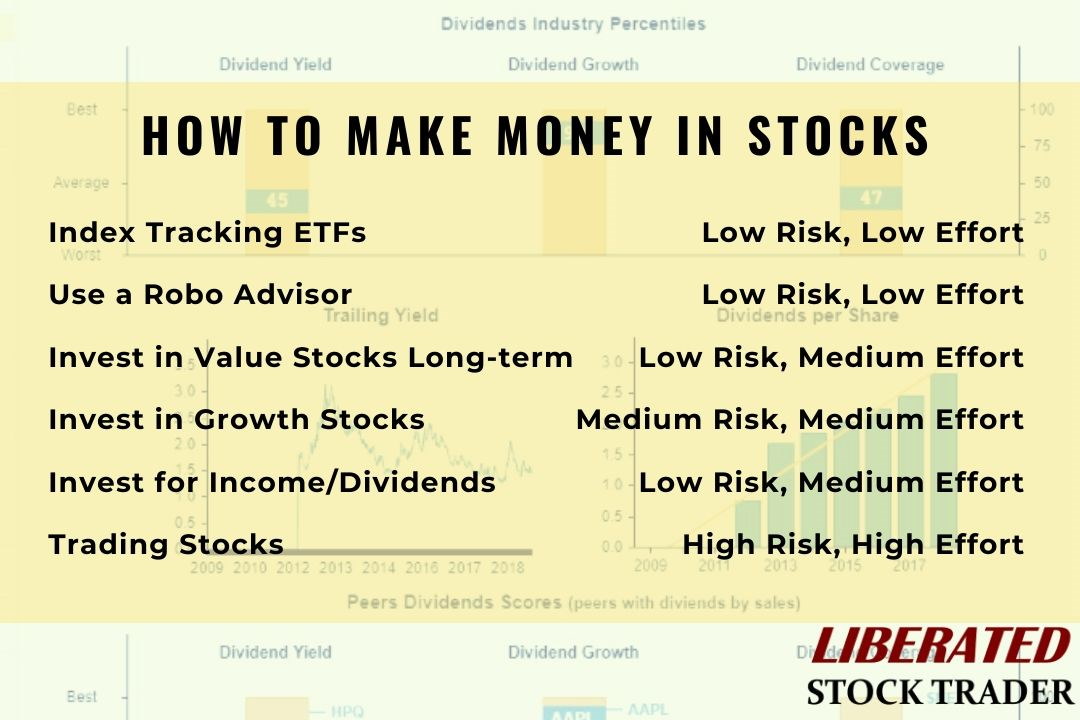
1. Invest in an Index ETF for the Long-term
Evidence suggests that the best way to make money in the stock market is to invest long-term for at least 20 years. Statistics show that in any 20-year period from 1930, the US stock markets have made a profit. In the previous 20 years, the NASDAQ 100 made 265%, the DJIA 144%, and the S&P500 made a 128% gain.
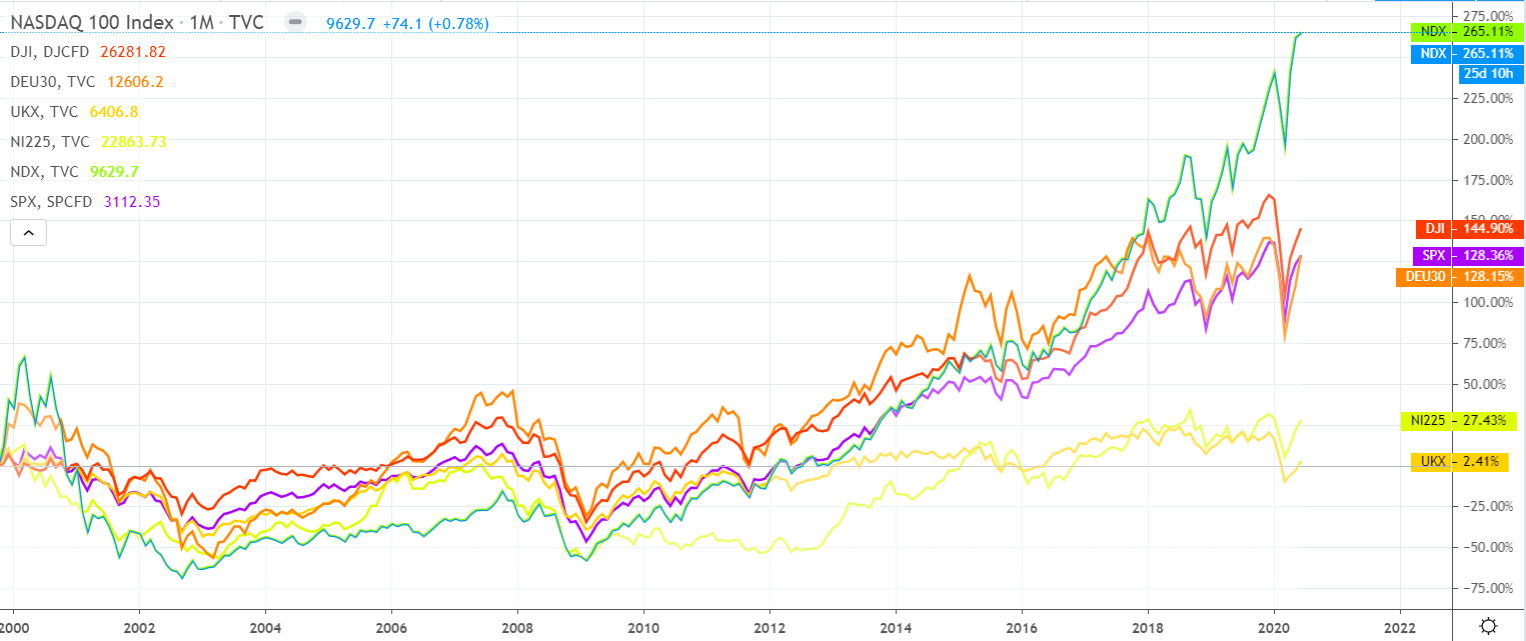
Screen for ETFs on TradingView
The Easiest Way to Make Money in Stocks
The facts show the easiest way to make money in stocks is to invest in a broad market passive index-tracking fund. Passive investing has seen considerable growth. It now accounts for 45% of all assets for US stock-based funds, up from around 25% a decade ago. Investing in a passive ETF is easy; you do not need to select stocks, your investment is diversified, and they have low management fees.
So, we can conclude that investing long-term in broad market index-tracking funds is the simplest and least risky way to make money in stocks. However other strategies could earn you more money, but they may require higher levels of effort to maintain your investment portfolio or contain more risk. Here, we highlight six ways to make money in stocks.
Since the invention of the index Tracking Fund by John Bogle of Vanguard, passive index funds have grown to be the single most significant investment vehicle in the USA and Europe. Because the funds are passive, not actively managed, the management fees tend to be very low, which means more profit for the investor rather than more profit for the fund manager.
Investing in Index Tracking Funds (ITF/ETF) makes a lot of sense in the USA because it has the best-performing stock markets in the world. As you can see from the chart below, the top-performing indices over the last 15 years are primarily the Nasdaq 100, S&P500, and the Dow Jones Industrial Average (DJ30)
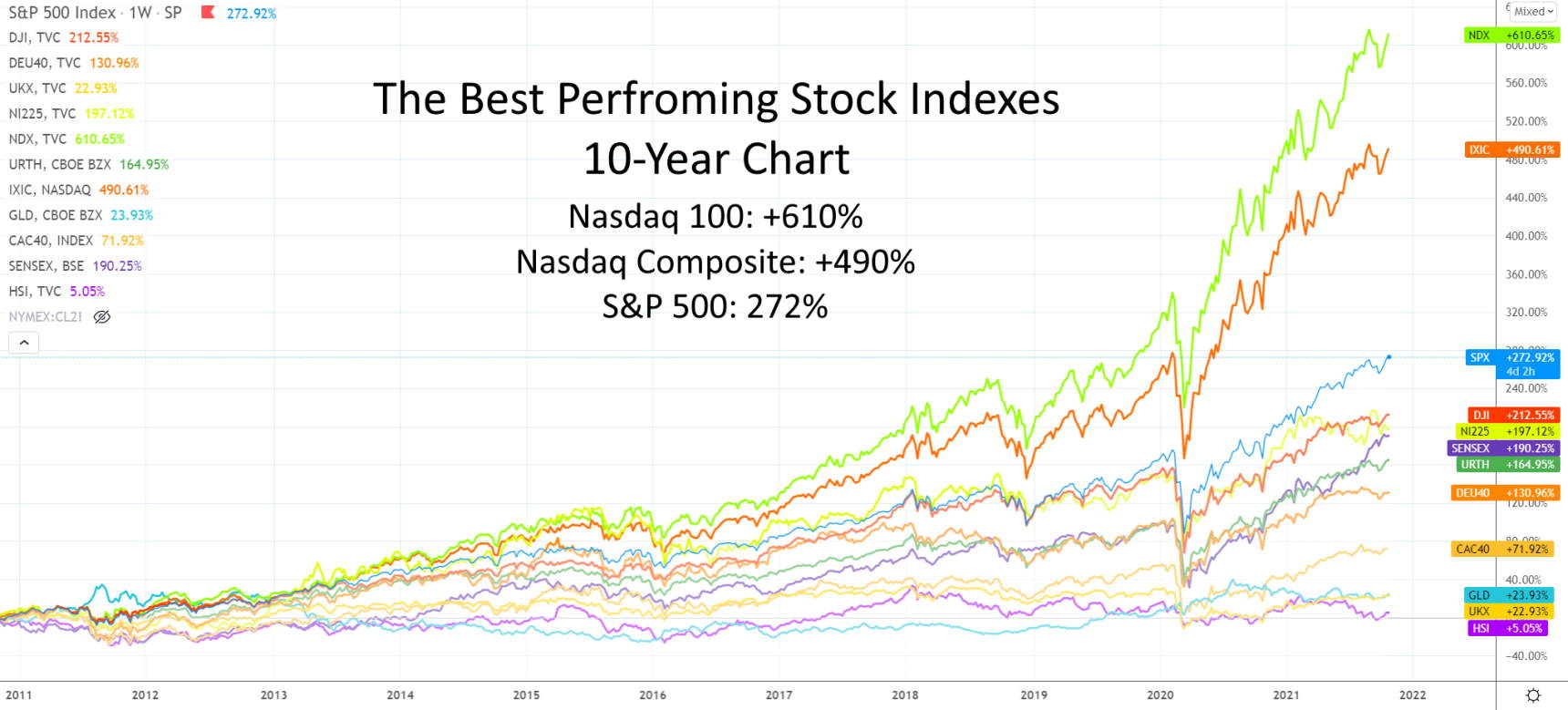
Screen for ETFs on TradingView
Stock Market 15-Year Performance
The above chart shows that the best-performing index over the last 15 years was the Nasdaq 100 (NDX), with a total growth of 499%. Here is the full list of 15-year results.
| Stock Market Index | 15-Year Total Growth |
| NASDAQ 100 (NDX) | 499.9% |
| German DAX (DUE30) | 158.06% |
| S&P 500 (SPX) | 152.18% |
| Dow Jones Industrials (DJI) | 146.99% |
| Japan Nikkei 225 (NI225) | 92.14% |
| UK FTSE 100 (UKX) | 21.30% |
Source: TradingView.com
Low Risk & Effort ETF investing
Investing in index-tracking ETFs is low risk because you are diversified across all stocks listed in that index. Of course, that does not protect you from the risk of a stock market downturn or crash. But do not forget that the growth and returns listed above are the results, including the 2008 Financial Crisis and the 2020 Corona Crash.
Employing this strategy requires minimal effort. Simply purchase and hold an ETF for an extended period through your broker or one of the excellent automated trading platforms in the USA.
10 Largest US ETF Funds 5-Year Performance Table
| Ticker | Name | Notes | Capitalization (Value $ Billion) | 5 Year Growth Rate (PA) |
| QQQ | Invesco QQQTrust Series | NASDAQ 100 Index ETF | $74.1 | 17.26% |
| VUG | Vanguard Growth ETF | US Growth Companies | $86.9 | 13.28% |
| VOO | Vanguard S&P500 | S&P 500 Index | $459 | 10.17% |
| SPY | SPDRs S&P500 Trust Series ETF | S&P 500 Index | $280 | 10.13% |
| VO | Vanguard Mid-Cap ETF | Mid Size US Companies | $102 | 7.79% |
| VB | Vanguard Small-Cap ETF | Small US Companies | $95.4 | 7.52% |
| VTV | Vanguard Value ETF | Undervalued US Stocks | $74.7 | 7.44% |
| VWO | Vanguard Emerging Markets | Emerging Market Stocks | $79.7 | 3.93% |
| VXUS | Vanguard Total International Stock ETF | Total World Stock Markets | $359 | -2.69% |
| VTI | Vanguard Total Stock Market ETF | Total US Stock Market | $756 | -3% |
This table highlights the largest, most stable index ETF funds available in the USA. Many of them have equivalent UCITS funds available for European investors. As you can see, the best broad market ETF fund to invest in over the last five years is the Invesco QQQ Trust Series (Ticker: QQQ), which returned 17.26% per year for the last five years.
Disclosure: I currently invest 50% of my investing capital in the Invesco QQQ Trust Series ETF, the most rewarding broad market ETF. The other 50% is invested in growth and value stocks in a medium-term investment strategy.
2. Use an Automated Robo Advisor
The simplest way to make money from the stock market is by using an automated or “Robo Advisor.” These automated systems are mainstream and owned by large investment firms like Vanguard and Morgan Stanley. The advisor will then construct a model portfolio for you, and then after you approve, it will automatically invest your money for you. In addition, many of the best Robo Advisors will automatically perform your tax-loss harvesting at the end of the year.
Robo-advisors have revolutionized the investment landscape, offering automated, algorithm-driven financial planning services with little human supervision. A Robo or Automated Advisor is simply an automated service that enables you to establish a stock portfolio based on your specific risk profile and investing preferences. You can choose the balance of capital you have invested in stocks and bonds and even specify a preference for particular industries or ethical preferences.
Many robo-advisors, like any human financial advisor, employ industry-standard Modern Portfolio Theory (MPT) to construct your portfolio. The big benefit is that the costs and management fees are much lower than with a human advisor.
Who Operates the Robo Advisors
In 2022, robo-advisors managed a staggering amount of assets worldwide. According to data, this figure surpassed $500 billion. Other sources cite an even higher figure, with robo-advisors managing $1.7 trillion of assets.
Among the robo-advisors, certain platforms led the pack regarding assets under management: Vanguard Personal and Digital Advisor Services, $118.99 billion, and Wealthfront, $34.0 billion.
Do Robo Advisors Beat the Market
The short answer is that most Robo Advisors fail to beat the market. Most Robo Advisors’ goal is not to beat the market but to automatically invest your money based on your requirements and risk tolerance. If you have a low tolerance for risk, your portfolio will be more heavily weighted in favor of bonds, which would inhibit the ability to beat the market.
Robo Advisor Fund Performance
Many Robo Advisor funds are not completely transparent in reporting their fund’s performance due to the complexity of options on offer not being directly comparable to the underlying index or, more likely because they do not beat the market and do not want to make false claims.
Evaluating Robo Advisor performance is difficult because there are vast differences between advisors. For instance, different advisors keep the customer’s money in cash at different levels.
Notably, Charles Schwab’s Intelligent Portfolios keep 6% of a customer’s investment in cash. To explain, a high level of cash lowers the exposure to market losses. Unfortunately, a high percentage of cash increases the exposure to inflation and lowers potential market gains.
On the other hand, most Robo Advisors keep less of a client’s money as cash. Also, some Robo Advisors could allow you to choose the level of funds in cash.
For instance, cash is a poor investment for a younger person saving for retirement or an individual with a high income. However, cash is a good investment for people with a limited income, such as retirees.
3. Invest in Value Stocks Long-term
According to Warren Buffett, value investing is the best way to make money in stocks. Over the last 50 years, he has proven to be the most successful investor ever. With an average compound rate of return of 23.3% per year, he and his good friend Charlie Munger have a reputation that Wall Street can only dream of. His wise investing has grown his company, Berkshire Hathaway (BRK.A), into a behemoth worth over $500 billion.
But how did Buffett achieve these great investing returns? He analyses stocks better than anyone else and understands what makes a great company.
The most detailed analysis of Buffett’s investing methodology is outlined in the book “The New Buffettology” by his daughter Mary Buffett. We will use the Buffettology book, plus the two most important criteria his mentor created, the great Benjamin Graham: Fair Value (Intrinsic Value) and Margin of Safety.
The Warren Buffett Value Stock Screener
A Warren Buffett Stock Screener needs to filter on investing criteria such as earnings per share (EPS) growth, consistent return on equity (ROE), high return on invested capital (ROIC), and low debt using the solvency ratio. Finally, the screener needs to calculate the margin of Safety using discounted cash flow (DCF).
How Does Buffett Screen for Stocks?
Buffett screens for stocks using specific criteria, such as whether the company is profitable and generating a healthy cash flow. He then predicts and discounts the cash flow ten years into the future. If the cash flow value is 30% higher than the company’s stock market valuation, then it has a good margin of Safety, and it is a candidate for purchase.
Specific Rules for the Warren Buffett Investment Include:
- Look for Fair Value Higher Than The Current Stock Price
- A High Margin Of Safety
- A Strong Earnings Per Share History & Growth Rate
- A Consistently High Return on Equity
- Does the Company Earn a High Return on Total Capital?
- Is the Company Conservatively Financed?
- The Initial Rate of Return for the Stock is Greater than The Return on US treasury bonds?
Our article: 4 Easy Steps to Build The Best Buffett Stock Screener details this entire methodology, criteria, and explanation of implementing this strategy.
Value Investing Strategies
Hundreds of research and testing hours have yielded us a selection of value-investing strategies and criteria we are proud to call our own. We will show you the criteria to meet your investing needs.
Whether you are looking for companies that offer great value and a large margin of Safety or looking for high dividend yield or continual dividend growth, we explain all the criteria and show you how to implement the value investing strategies for yourself.
Value Investing Effort & Risk
The effort to implement a value investing strategy is undoubtedly a lot higher than investing in an index or using a Robo Advisor but a lot lower than trading stocks. In terms of risk, risk minimization is a core part of the strategy. Using the Margin of Safety Method means you inherently buy stocks undervalued compared to their intrinsic value (the combined sum of the 10-year cash flow).
4. Invest in Growth Stocks
William J. O’Neil’s book “How to Make Money in Stocks” suggests that the CANSLIM method is the best strategy for stock investing. He designed it to produce market-beating profit performance. Using the CAN SLIM criteria in your investing should mean profitable returns. Current Earnings, Annual Earnings, New Products, Supply, Leaders, Institutional Sponsorship, and Market Direction are vital criteria.
It combines fundamental analysis and technical analysis into a cohesive strategy.
The CAN SLIM Criteria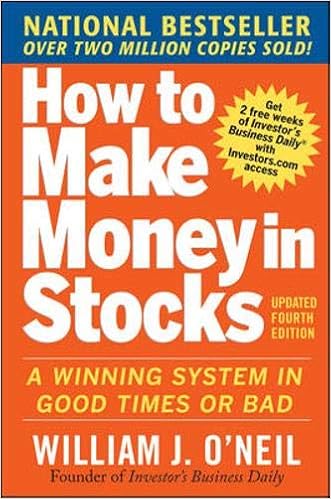
- C – Current Earnings
- A – Annual Earnings
- N – New Products or Management
- S – Supply and Demand
- L – Leaders
- I – Institutional Ownership
- M – Market Direction
The full breakdown of each of the elements of this strategy, criteria, and how to implement this screener can be found here: A CANSLIM Stock Screener Strategy To Beat the Market.
You can also deep dive into CANSLIM in our What is CANSLIM Article.
Implement CANSLIM with a Stock Screener
Here are the 5 Steps to implement the Stock Rover CANSLIM stock screening strategy.
1 – Register with Stock Rover
You will need a Premium Plus Membership, which gives you access to all the criteria and the database with a unique 10-year history. It will also allow you to implement all our Warren Buffett screeners, our full list of stock screening strategies, and our dividend growth and dividend yield strategies.
2 – Browse Screener Library
- See the image to the right.
- Launch Stock Rover and select:
- Screeners (Down Arrow)
- Browse Screener Library
- This takes you to the following screen.
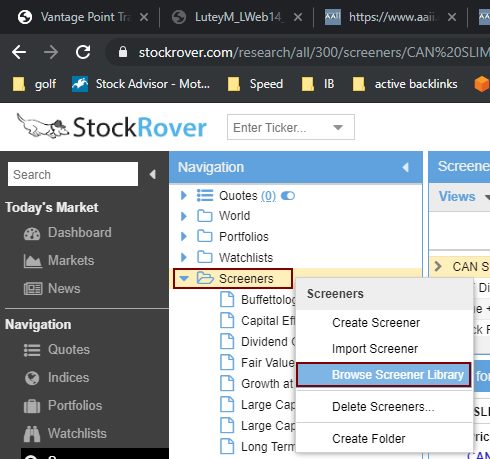
3 – Import CANSLIM Screeners
Stock Rover has a built-in screen for CANSLIM called “CAN SLIM – Less Restrictive,” with a very good performance record.
This is the screener we will be using.
- In the Screeners, search box type “CAN SLIM.”
- Select the two CANSLIM Screeners
- Click Button – Import (2 Items Selected)
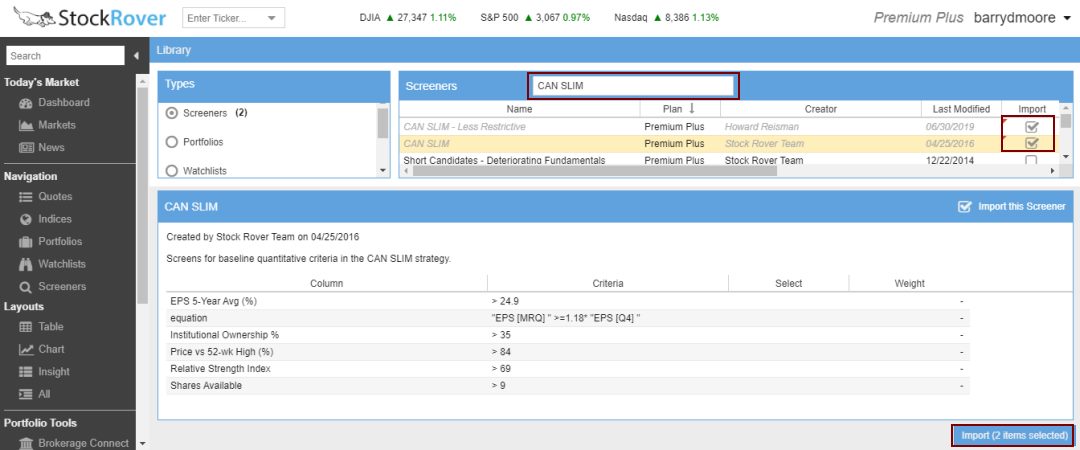
4 – View the Portfolio Performance
Now that you have imported the screener, here is how to set up the excellent comparison view vs. the S&P 500
- Select Screeners
- Select the CAN SLIM – Less Restrictive Screener
- In the Chart Below, Select “Compare To.”
- Select Benchmarks
- Select S&P 500 or NASDAQ
- Select Return Vs. S&P 500 Column Views
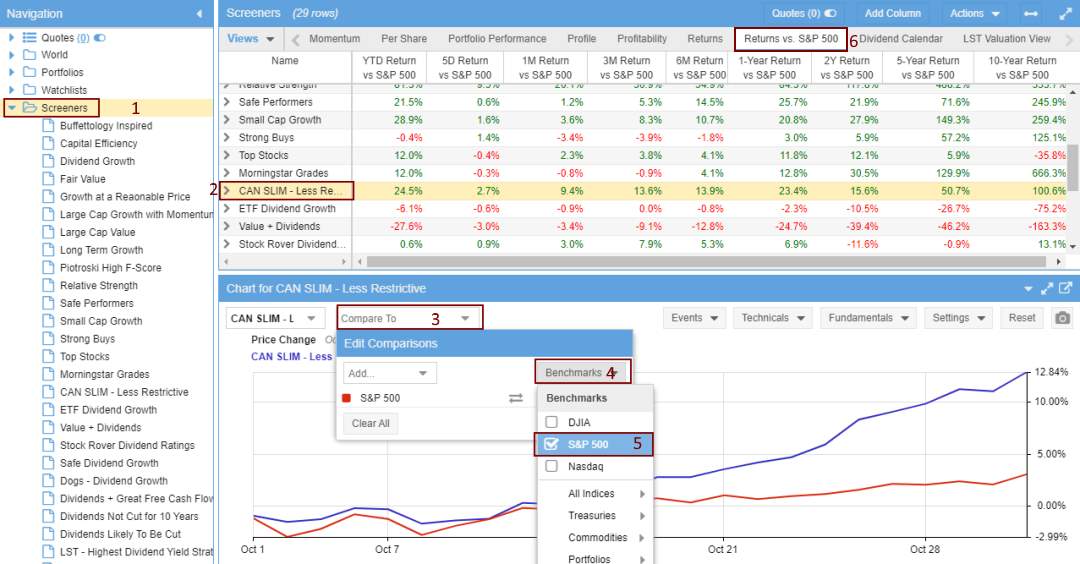
Growth Stock Investment Strategies Risk and Effort
Investing in growth stocks can become time-consuming as you must maintain a good overview of your stock portfolio’s performance. Luckily, services like Stock Rover do a lot of the heavy lifting for you, but you will still need to research and decide which stocks you purchase.
In contrast to a value investing strategy, which looks for undervalued stocks to minimize risk, the growth strategy looks for stocks with explosive growth in earnings and sales. This means that the stock might be excessively priced. If the company fails to meet earnings expectations, the stock could erratically lose value; therefore, I would class this as a medium-risk investing strategy.
5. Dividend Investing
For investors seeking a stable income higher than bond returns, dividend investing is the best way to make money in stocks. Dividend investing is an attractive strategy as it can earn income from stocks without selling shares. Companies that offer dividends typically have high levels of intrinsic value, and investors can benefit from compounded returns by reinvesting dividend payments into additional shares in the same stock.
To maximize this strategy, you could look for stocks with higher dividend yields than the current inflation rate. However, market fluctuations and other factors that affect stock prices can still affect dividend stocks.
Ultimate Guide to Dividend Investing with 4 Proven Strategies!
Dividend investors typically employ the Dividend Kings or Dividend Aristocrats approach. This essentially means investing in companies with a long history of continually paying and increasing dividends.
For this, you will need a stock screener with a significantly large historical database (at least ten years) of earnings and dividend payments, such as Stock Rover.
Investing In Stocks Can Be Complicated, Stock Rover Makes It Easy.
Stock Rover is our #1 rated stock investing tool for:
★ Growth Investing - With industry Leading Research Reports ★
★ Value Investing - Find Value Stocks Using Warren Buffett's Strategies ★
★ Income Investing - Harvest Safe Regular Dividends from Stocks ★

"I have been researching and investing in stocks for 20 years! I now manage all my stock investments using Stock Rover." Barry D. Moore - Founder: LiberatedStockTrader.com
The criteria shown here is the calculation for ten years.
Dividend Aristocrats 10-Year Dividend Growth Strategy
Dividend Growth Criteria Explanation:
- Dividend Yield > 1.5%. This is a simple filter designed to ensure only companies paying a dividend above 1.5% are listed—anything less than 1.5% will not even pay in line with inflation.
- Dividend 1-Year Change > 8%. Here, we want only companies with increased dividends in the last fiscal year of over 8%.
- Dividend 3-Year Change > 8%. Next, we filter down to those companies with at least an average increase of 8% over the last three years.
- Dividend 5-Year Change > 8%. Again, only those companies increased dividends by more than 8% over the last five years.
- Dividend 10-Year Change > 8%. You get the idea.
- Payout Ratio >10 < 40. The payout ratio ensures the company makes enough profits to continue paying dividends and sustain the increases. You can reduce the “<10” to see more stocks in the scan. We do not want companies to pay more than 40% of their profits in dividends; they must retain cash flow for future growth and capital investments.
- Sales 5-Year Average (%) > 4%. This is designed to ensure that the company is increasing sales, at least on average, to pay for the growth in dividends.
- Margin of Safety> 0. (Exclusive to Stock Rover) For me, the most important criterion of all the Margin of Safety, using Warren Buffett’s calculation, is the forward discounted cash flow (see our article on Intrinsic Value). Essentially, the higher the margin of Safety, the more of a discount you buy a stock for.
These criteria would typically return a list of only 2% of the NYSE or NASDAQ listed stocks.
Dividend Investing Effort and Risk
The effort required to implement a dividend investing strategy is significantly reduced by using a tool such as Stock Rover, which maintains a robust research and historical 10-year database of all the important metrics and measures you will need. There are also many off-the-shelf tested screeners to help you find the stocks that meet your criteria. They have also implemented a reporting system that enables you to forecast the future income you will receive from your constructed portfolio; this is incredibly valuable.
6. Trading Stocks
For investors looking to maximize profits, the best way to make money from stocks is by trading. There are many ways to trade stocks, including day trading, swing trading, momentum trading, and scalping, all of which are high-risk.
Learning stock trading takes a lot of work. There are no shortcuts, but you can teach yourself by learning from the wealth of books, videos, podcasts, and training courses available. It would be best to treat your investing seriously and not take undue risks with your capital; there are no get-rich-quick schemes.
Do not believe others when they say it is easy to learn; they probably want to sell you a course or access to a trading room. You can, of course, teach yourself, and we have many great resources you can utilize.
The Quickest Way to Make Money in Stocks
Stock trading is the quickest way to make money in stocks and is the highest risk. Conversely, shorting stocks is the quickest way to lose money in stocks because the default market direction is up.
Before jumping into trading stocks, understand your risk tolerance and what strategies you are comfortable with. The key is to trade within your experience level and never overreach. It can be easy to fall into the trap of chasing returns or taking too much risk.
Our research on successful chart patterns, candlestick patterns, and the best-performing stock chart indicators is a great place to start.
10 Great Resources for Learning Stock Trading
- Learn Stock Trading from Books
- Watch Movies to Learn About Stock Markets
- Watch Our Learn to Trade Video
- Listen to Trading Audio Books
- Get a Free Stock Trading Course
- Get Professional Stock Market Training
- Get Free Stock Analysis Tools
- Get the Best Stock Trading Software
- Prepare Your Trading Strategy
- Avoid Stock Market Crashes
Summary: The Best Way to Make Money in Stocks
The best way to make money in stocks is mostly personal preference. Investing in index-tracking ETFs or using Robo Advisors is a great way to start. If you enjoy researching and building your portfolio of stocks, value or growth investing strategies are rewarding. Trading could be a good option if you want to invest time in learning.
FAQ
What software is best for making money in stocks?
The best software for making money in stocks is strategy-dependent. Stock Rover is the best for dividend, value, or growth investing strategies. For day trading, Trade Ideas is the best, and for swing trading, Trendspider is the best. For all international traders, TradingView is the best.
How do you make money from stocks?
The primary way to make money from stocks is by buying shares at a low price and selling them at a higher price. You can also earn through dividends, which are a portion of the company's profits distributed to shareholders.
What is the best strategy for making a profit in stocks?
Data shows that a long-term 'Buy and Hold' approach using broad market ETFs is the best way to make 7% to 12% per year in stocks. Opting for short-term strategies like day trading might increase your profits but significantly increase your chance of losses.
What is the quickest way to make money in stocks?
Day trading is the quickest way to make money in stocks as it involves buying and selling shares within a single trading day. However, this strategy carries significant risks and requires a deep understanding of stock charts, patterns, and indicators.
How do you lower risks while making money in stocks?
To lower risks while making money in stocks, diversify your portfolio by investing in different sectors or industries. This can help spread the risk as your investments aren't tied to the performance of a single company.
How do you maximize profits in stock trading?
To maximize profits in stock trading, you will be increasing your risk. It is possible to buy short-term call options with the potential of maximum profits of 50% or more in one week, but they can also expire worthless, losing your entire investment.
How do you make money from dividend stocks?
To make money in dividend stocks, our research suggests investing in companies that regularly pay out dividends between 2% and 6% and have a payout ratio of less than 40%. Additionally, choose companies with at least five years of dividend growth.
What software is best for making money in dividend stocks?
The best software for making money in dividend stocks is Stock Rover. Stock Rover enables you to research and create detailed dividend investing strategies and forecast future dividend income. It will even help you rebalance your portfolio to maximize dividend income.
What’s the lowest-risk way to make money in stocks?
The lowest-risk way to make money in stocks is by combining the 'Buy-and-Hold' strategy with "Dollar Cost Averaging." It banks on the historical upward trend of the stock market over time. Diversifying your portfolio and investing in funds can also help spread the risk.
How do you make a consistent profit in stocks?
Consistent profits often come from a disciplined approach that includes regular investment (such as dollar-cost averaging), diversification, and long-term strategies like 'Buy and Hold.'
What strategies work best for making money in bear markets?
In bear markets, short selling can be profitable. This strategy involves borrowing shares to sell, hoping to buy them back at a lower price. However, it's incredibly risky and requires an expert understanding of market trends.
How do you make money in bull markets?
Most stocks tend to rise in bull markets, so buying and holding stocks or investing in index funds that track the broader market can be profitable strategies.
What software is best for making money in value stocks?
The best software for making money in value stocks is Stock Rover. Stock Rover has unique screening criteria to help you find the best value stocks, such as fair value, margin of safety, the Graham number, and intrinsic value.
How do you make money from growth stocks?
Our research shows the best way to make money from growth stocks is to select stocks with a history of outperforming the S&P 500 index. Combining stocks with high past performance and strict financial health measures is a good strategy.
What software is best for making money in growth stocks?
The best software for making money in growth stocks is Stock Rover. Stock Rover enables you to craft detailed growth stock investing strategies and backtest them on the previous ten years of data.



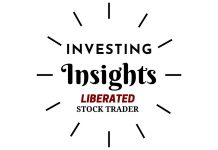

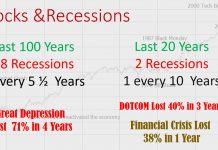
This has been very helpful. In the past four years, I have been very successful with my strategies. I wish I would have done it twenty years ago. There is never a bad time to start.